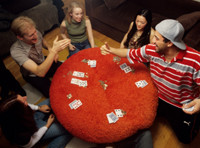|
|
|
| |
 |
|
A relative newcomer to casinos, Spanish 21 is a game steadily rising in popularity. This is played on the same table, and in the same format, as Blackjack. The differences between Blackjack and Spanish 21 though, while small, are highly consequential in how you play the game. Before heading to a casino to conquer the world of Spanish 21, it is a really good idea to become familiar with the difference in the rules and strategies! |
|
|
This game employs the use of a 48 card deck, rather than the standard 52 card deck. In this new deck all the 10’s have been removed. J’s, Q’s, and K’s still have the value of 10, but still your chance of getting a blackjack or a 21 when doubling down on an 11 are decreased by 4 cards per deck used. Despite this reduced chance, the advantage is somewhat balanced out by a player’s blackjack winning over a dealer’s blackjack, and a player’s 21 beating a dealer’s 21.
If you do get 21, there are bonuses paid on various combinations of how you got there. There are bonuses on 21’s that are made out of the hands “6, 7, and 8” or “7, 7, and 7”, as well as for 5, 6, and 7 Card Charlie’s (21 made out of either 5, 6, or 7 cards).
Whether you are a novice to spanish 21 games, or have been playing Blackjack forever, it’s well worth the little bit of reading time to go through the rules, tips, and strategies in order to learn the differences between Spanish 21 and regular Blackjack. Those with Blackjack experience will want to revise some of their strategies in how they play this game.
Read on and enjoy the game! |
|
| |
 |
|
The only real strategy is what to do with what cards!
» Always split aces
» Never split 4’s, 5’s, or cards with a value of 10 (J’s, Q’s, and K’s)
» 2’s and 3’s: split when the dealer shows a card from 3-7
» 6’s: split if the dealer shows a 4, 5, or 6
» 7’s: split if dealer shows 2-7 » 8’s: Split against all but an Ace
» 9’s: Split when dealer shows anything but an A, 2, 7, or Face card |
|
|
That covered the splits, but what about hitting, standing, and doubling? The basics: If you have a hard 18 or higher, or a soft 19-21 you want to stand. If your cards total 9 or lower, or are a soft 13, 14, 15, or 17) you should definitely hit. The only exception to the above rules are if you total 9 and the dealer shows a 6…then your best bet would be to double down. Now for the rest!
» Soft 16: double down if dealer shows 6, unless you have 4 or more cards – then you aim for 5+ Card Charlie. Hit against all other cards.
» Soft 18: hit against a shown 9, 10 values, or Ace.
» Hard 10 & 11: always double down
» Hard 12: always hit
» Hard 13: stand on shown 5 & 6 unless your 13 is of 5 or more cards. Hit on all others.
» Hard 14: hit on 2, 3, or 7 and higher. Hit against a 4 if your 14 is of 4+ cards, or against 5 & 6 with 5+ cards
» Hard 15: hit against 7 or higher
» Hard 16: surrender to a shown Ace, or hit against a 7 or higher
» Hard 17: surrender to a shown Ace, otherwise stand unless dealer shows an 8, 9, or 10 and your 17 is of 6 cards…then hit!
If it seems intimidating to recall all these “What to do when…” the best strategy is to employ the use of a free room and practice until you get the hang of it. Many wonderful casinos offer you these rooms so that you can practice, hone, and refine your gambling skills without working with your hard earned money. For a listing of the best casinos that offer this game and free rooms, visit our Casino Review section! |
|
| |
 |
|
Some rules in Spanish 21 are the same as Blackjack, some are different. Whether new to 21 type games or an experienced hand, it’s always a good idea to familiarize yourself with the rules and the differences in the games
If both the dealer and the player have a blackjack, the player wins. If they both have 21, regardless of how many cards have been played, the player also wins. For all other ties it’s still considered a push, and no wins are collected. |
|
|
Recall that a blackjack is a face card and an ace on the first two cards dealt, while 21 is a combination of cards added to the total of your first cards. If the player has 21 and the dealer has a blackjack, the blackjack still wins.
You are allowed to double down after seeing any number of “hit” cards, not only after seeing your first two. Some casinos allow you to “double double down” which is doubling on the same hand that you’ve already doubled. If you don’t like the card you get dealt after doubling, you can use a “double down rescue”. You forfeit your original bet, but keep your double bet.
On hands not doubled down, you can use the “late surrender” option which (provided the dealer doesn’t have 21) allows you to retain half your bet in exchange for not playing out the hand.
You are allowed to split up to four cards. If you get dealt 4 2’s you can split them into 4 separate playing hands. You are allowed to double down after all splits and can, again, double down even after receiving “hits”.
Spanish 21 is almost always played as “Dealer Hits on Soft 17”. In Blackjack it is more often than not that the dealer stands on all 17’s, here it is not so. If the dealer reaches a soft 17 (meaning his cards total 17, but one of those is an ace that can lower his 17 by being played as 1 point rather than 11) the dealer must take another hit. This increases the dealer’s odds of busting and, so, works to your advantage.
Now that you’ve familiarized yourself with the rules, stop by the Tips and Strategy sections for little hints which can help improve your game play. May the good cards all be yours! |
|
| |
 |
|
The number one tip that can’t be mentioned often enough is to practice, practice, and practice…especially when trying a new game, or a new version of a favorite game. This holds especially true for a game such as Spanish 21 which has so many different rules from regular Blackjack. The best place to practice your skills, without jeopardizing your bankroll, is in the free/practice rooms offered by many online casinos. Use our Casino Review section to find links to the best casinos offering free rooms for this game. |
|
|
Don’t be put off by the lack of 10’s in the deck. Though it does raise the house average slightly, the changes in other rules favor the player so it is all balanced out in the end.
If you are having a hard time remembering what strategy to use against which cards, another good idea is a Strategy Chart. A strategy chart is more or less a “cheat sheet” which is not only legal, but often found in land-based casinos as either a give-away or sold for a nominal price to place beside the player right at the table! All these charts do is give you clues as to “what to do if…” when you are indecisive as to what you should do.
Once in a while it is a good idea to up mix up your bet. A rule of thumb for this is that if you’ve lost more than you’ve won in the last ten hands, lower your bet. If you won more than you’ve lost in the last ten hands, raise your bet. This will save you some cash on your down times, while raising your incoming cash on the up times.
So, when it comes to Spanish 21 don’t be scared and remember to practice before you hit the real money tables. May all the luck be in your “hands”. |
|
|
|
|
| |
|
|
|
|